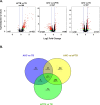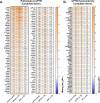Unique transcriptomic landscapes identified in idiopathic spontaneous and infection related preterm births compared to normal term births
- PMID: 31703110
- PMCID: PMC6839872
- DOI: 10.1371/journal.pone.0225062
Unique transcriptomic landscapes identified in idiopathic spontaneous and infection related preterm births compared to normal term births
Abstract
Preterm birth (PTB) is leading contributor to infant death in the United States and globally, yet the underlying mechanistic causes are not well understood. Histopathological studies of preterm birth suggest advanced villous maturity may have a role in idiopathic spontaneous preterm birth (isPTB). To better understand pathological and molecular basis of isPTB, we compared placental villous transcriptomes from carefully phenotyped cohorts of PTB due to infection or isPTB between 28-36 weeks gestation and healthy term placentas. Transcriptomic analyses revealed a unique expression signature for isPTB distinct from the age-matched controls that were delivered prematurely due to infection. This signature included the upregulation of three IGF binding proteins (IGFBP1, IGFBP2, and IGFBP6), supporting a role for aberrant IGF signaling in isPTB. However, within the isPTB expression signature, we detected secondary signature of inflammatory markers including TNC, C3, CFH, and C1R, which have been associated with placental maturity. In contrast, the expression signature of the gestational age-matched infected samples included upregulation of proliferative genes along with cell cycling and mitosis pathways. Together, these data suggest an isPTB molecular signature of placental hypermaturity, likely contributing to the premature activation of inflammatory pathways associated with birth and providing a molecular basis for idiopathic spontaneous birth.
Conflict of interest statement
The authors have declared that no competing interests exist.
Figures




Similar articles
-
Characterization of methylation profiles in spontaneous preterm birth placental villous tissue.PLoS One. 2023 Mar 23;18(3):e0279991. doi: 10.1371/journal.pone.0279991. eCollection 2023. PLoS One. 2023. PMID: 36952446 Free PMC article.
-
Prenatal inflammation as a link between placental expression signature of tryptophan metabolism and preterm birth.Hum Mol Genet. 2021 Nov 1;30(22):2053-2067. doi: 10.1093/hmg/ddab169. Hum Mol Genet. 2021. PMID: 34169316 Free PMC article.
-
Comparative transcriptomic analysis of human placentae at term and preterm delivery.Biol Reprod. 2018 Jan 1;98(1):89-101. doi: 10.1093/biolre/iox163. Biol Reprod. 2018. PMID: 29228154 Free PMC article.
-
The Role of Genetics in Preterm Birth.Reprod Sci. 2023 Dec;30(12):3410-3427. doi: 10.1007/s43032-023-01287-9. Epub 2023 Jul 14. Reprod Sci. 2023. PMID: 37450251 Free PMC article. Review.
-
Role of the Placenta in Preterm Birth: A Review.Am J Perinatol. 2016 Feb;33(3):258-66. doi: 10.1055/s-0035-1570379. Epub 2016 Jan 5. Am J Perinatol. 2016. PMID: 26731184 Review.
Cited by
-
Preterm Labor, a Syndrome Attributed to the Combination of External and Internal Factors.Matern Fetal Med. 2021 Dec 16;4(1):61-71. doi: 10.1097/FM9.0000000000000136. eCollection 2022 Jan. Matern Fetal Med. 2021. PMID: 40406574 Free PMC article. Review.
-
Fetal spina bifida associates with dysregulation in nutrient-sensitive placental gene networks: Findings from a matched case-control study.Clin Transl Sci. 2024 Jan;17(1):e13710. doi: 10.1111/cts.13710. Clin Transl Sci. 2024. PMID: 38226444 Free PMC article.
-
Placental transcriptomic signatures of spontaneous preterm birth.Am J Obstet Gynecol. 2023 Jan;228(1):73.e1-73.e18. doi: 10.1016/j.ajog.2022.07.015. Epub 2022 Jul 19. Am J Obstet Gynecol. 2023. PMID: 35868418 Free PMC article.
-
A Comprehensive Assessment of Associations between Prenatal Phthalate Exposure and the Placental Transcriptomic Landscape.Environ Health Perspect. 2021 Sep;129(9):97003. doi: 10.1289/EHP8973. Epub 2021 Sep 3. Environ Health Perspect. 2021. PMID: 34478338 Free PMC article.
-
Multiomic signals associated with maternal epidemiological factors contributing to preterm birth in low- and middle-income countries.Sci Adv. 2023 May 24;9(21):eade7692. doi: 10.1126/sciadv.ade7692. Epub 2023 May 26. Sci Adv. 2023. PMID: 37224249 Free PMC article.
References
-
- Dimes M of. 2018 PREMATURE BIRTH REPORT CARD. In: 2018 PREMATURE BIRTH REPORT CARD [Internet]. Available: https://www.marchofdimes.org/mission/prematurity-reportcard-tv.aspx
Publication types
MeSH terms
Grants and funding
LinkOut - more resources
Full Text Sources
Other Literature Sources
Molecular Biology Databases
Research Materials
Miscellaneous

